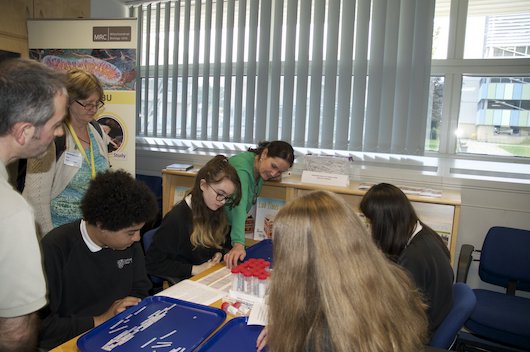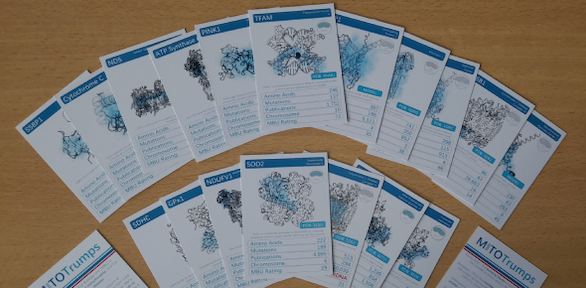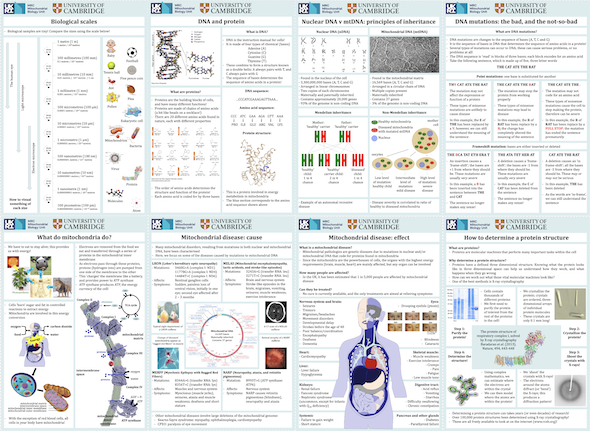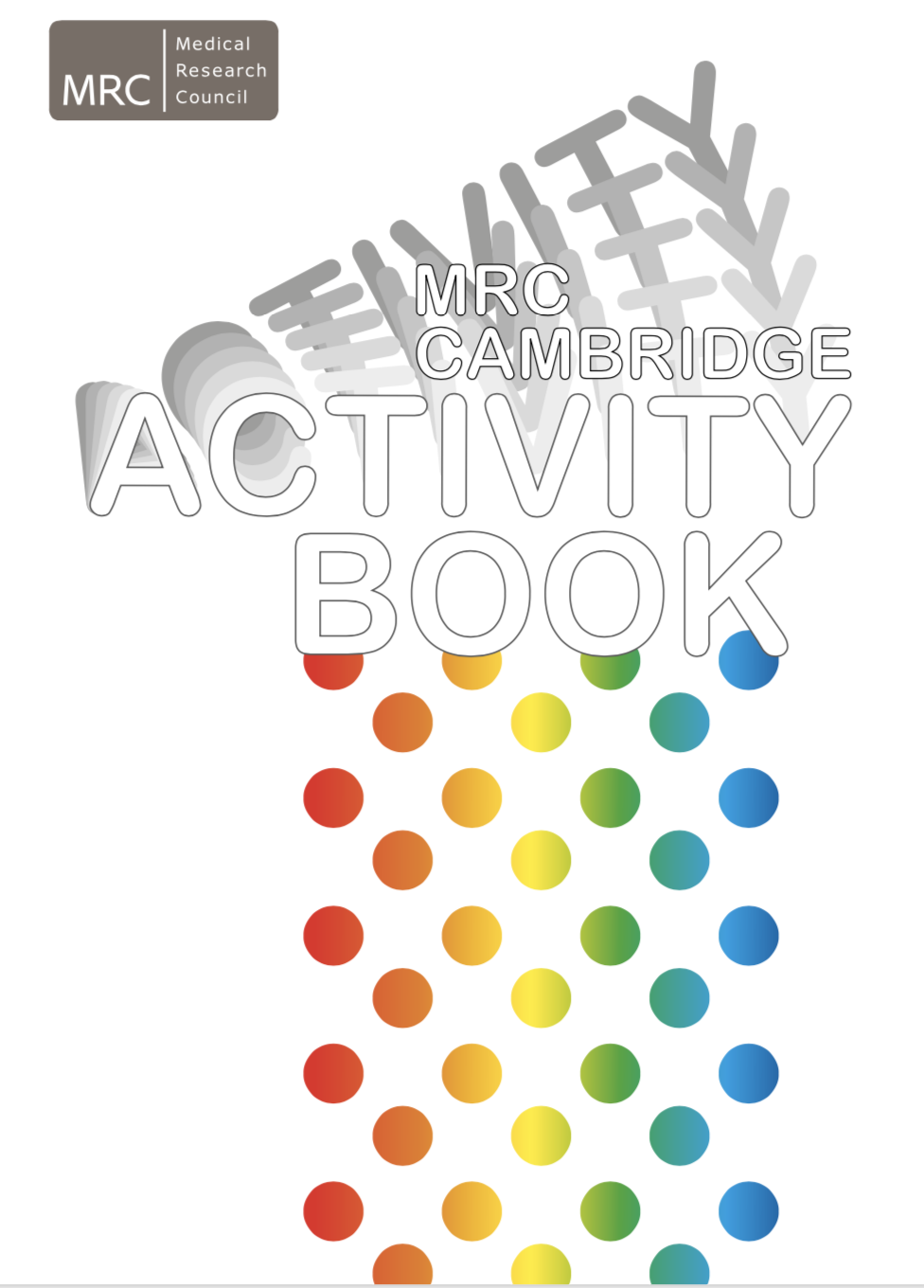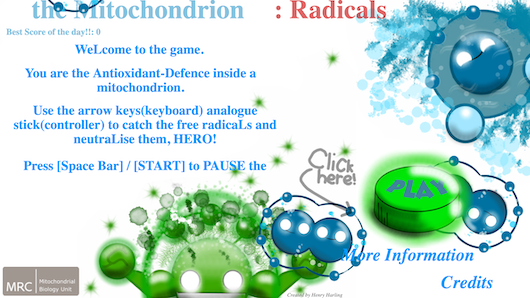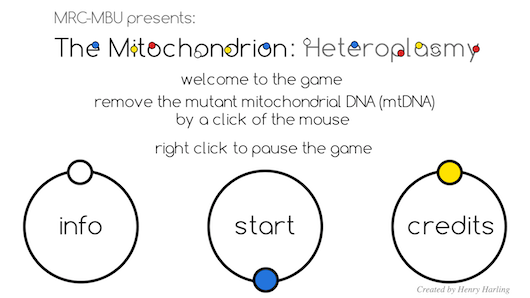Useful resources for Schools and Colleges
Current content:
- MITOTrumps card game - launched virtually at the Cambridge Festival 2022
- Videos about mitochondria
- Posters explaining mitochondrial diseases - causes, effects and principles of inheritance through mitochondrial DNA (mtDNA)
- Fiendish sequencing puzzles - very useful in explaining the methodology involved in DNA sequencing
- Activity Book
- Video games that demonstrate the effects of mitochondrial diseases. Click the images to play.
Welcome to the launch of our MITOTrumps card game!
About MITOTrumps
MITOTrumps is a card game for all ages, based on mitochondrial proteins, to introduce scientists and non-scientists alike to the exciting world of mitochondrial protein biology.
On each card there is an image of a mitochondrial protein, along with numerical statistics relating to that protein - amino acid number, mutations (the number of variants listed on gnomAD), publications, chromosome number, and an MBU rating. Each card has a picture of either the structure of the protein (in a complex, if relevant), a closely related structure (e.g. the bovine ortholog), or an Alphafold model. There is also a short sentence describing the protein and a little bubble with the location of it within the mitochondria.
To play
The cards in a deck are divided equally between the players, with each player holding their cards in a stack facing them such that they can only see their own top card. One player reads out a statistic and their score e.g. Amino acids 298, and all the other players check the number of amino acids on their top card. The person in the group with the highest number of amino acids gets to take each of the cards from the other players and add it to the back of their deck. They then call the next stat! This continues until one person has all of the cards, and they are declared the winner.
As our participation in this year’s Cambridge Festival was virtual, we shared the game as a .pdf for our visitors to download, print and play, and it is still available here.
To save ink, you might prefer to set the printing to single-side; odd pages only.
MITOTrumps (4 cards to one A4 page)
MITOTrumps (8 cards to one A4 page)
We also have a limited number of MitoTrumps packs that we can send to schools. To order, please complete this order form.
Feedback
We welcome feedback about our audiences and how you found this activity. Please take a few moments to complete our feedback questionnaire.
Thank you!
Further Information
MitoTrumps is also featured in the Biochemical Society's list of curated content packages and is hosted on the Portland Press website - where you can find further information about mitochondria.
Acknowledgements
We would like to thank members of the MBU who helped to develop this game, particularly its creator, Alannah King (PhD student), Cambridge Reprographics, TenHats, the 1st Stapleford Brownies. We also thank the Biochemical Society for its promotion of this resource.
MBU Public Engagement Committee
The MBU has an active engagement programme with local, national and sometimes international schools. This involves visits to the schools by MBU scientists and also the hosting of visits to the Unit by school students.
A number of our scientists have represented the Unit at careers carousels and other events organised by Form the Future - is an organisation that facilitates such events.
We also offer a Biology Masterclass (approximately 2 hours' duration) aimed at Year 13 A Level students. This Masterclass is split into three sections:
We cover mitochondrial biology and respiration to the level the students need to know for their A-levels. In this section, we aim to replicate lecture-style teaching taught at university (approximately 45 minutes)
The second section is structured like a small-group university teaching session. We explain the differences between science at school and research science, focusing on the ADP/ATP carrier, a protein central to mitochondrial energy metabolism. This section introduces students to concepts they are not familiar with, similar to university. We explain the sort of experiments we do in research, with an example of a project the lab has just finished that took 12 years to complete. We will then have an interactive discussion session (approximately 45 minutes)
Finally, there is a question and answer session, in which 6 questions that have been previously asked are answered, before additional questions are taken from the attendees (approximately 15 minutes)
Inside the human cell
Mitochondrial dynamics
Mitochondrial fission and fusion
The molecular mechanism of transport by the mitochondrial ADP/ATP carrier
The attached posters explain:
- Biological samples and how we view them
- DNA and protein
- Nuclear DNA v mtDNA: principles of inheritance
- DNA mutations: the bad, and the not-so-bad
- What mitochondria do
- Mitochondrial disease: cause
- Mitochondrial disease: effect
- How to determine a protein structure
- The battle for the mitochondrion!
Click the links for downloadable .pdf versions.
Fnidnig teh msitkaes ni DNA taht casue mitochondrial diseases
So - what do word puzzles have to do with genetic disease?
We each have about 3,000,000,000 billion bases of DNA – that’s the A’s, T’s, G’s and C’s – strung together in the famous double helix. But that DNA isn’t all as one long piece, it is divided into 23 pairs of chromosomes. One half of our chromosomes we get from out mother, and the other half from our father.
Our chromosomes contain about 20,000 genes. We all have small variations in our DNA that make us unique – these variations are how evolution can work – But sometimes these variations can stop a gene from producing a protein that works. It’s like how changing one letter in a sentence can change it’s meaning:
There’s a fly in my soup versus There’s a fly in my soap
If a change occurs in an important gene, then it can lead to genetic disease. When we sequence the DNA of a patient with genetic disease, we hope we can find the gene with the change that caused the disease by comparing it to the DNA of people without genetic disease.
But DNA is too long to sequence all in one go. Instead we sequence it in short pieces of up to 500 bases long, and then stick all the billions of pieces back together again! We do this by using computers that find all the over-lapping pieces. But you’re going to do it by hand. You’ll also discover that it’s not always easy, because sometimes DNA has repeated patterns. And sometimes the sequencing machines make mistakes too! So we need to overlap lots of fragments to make sure we’ve found a real change in the patient’s DNA.
Have a go - attached are a few sequencing puzzles in .pdf form. You will need to download them and cut them up into strips (the cutting lines are marked), then assemble them in the correct order.
- DNA normal
- DNA variant
- DNA variant (with one error per line)
This activity book is for people of all ages to explore the variety of MRC-funded work that takes place in Cambridge.
For further information about any of these activities, or to arrange a school visit or event, please use the Communications and Public Engagement email address found on our contacts page.
There is a bug in Heteroplasmy, but it still works by following this workaround. Once the tutorial has been completed, the game jumps to Level 10. Just keep clicking on this page and it will then ask you to click to continue. Clicking will move you on to the scores table (Top Times). Clicking on the green text on the bottom right of this screen will take you back to the level selection page, from where you can click on the “easy” button and the game will start again at Level 1.


